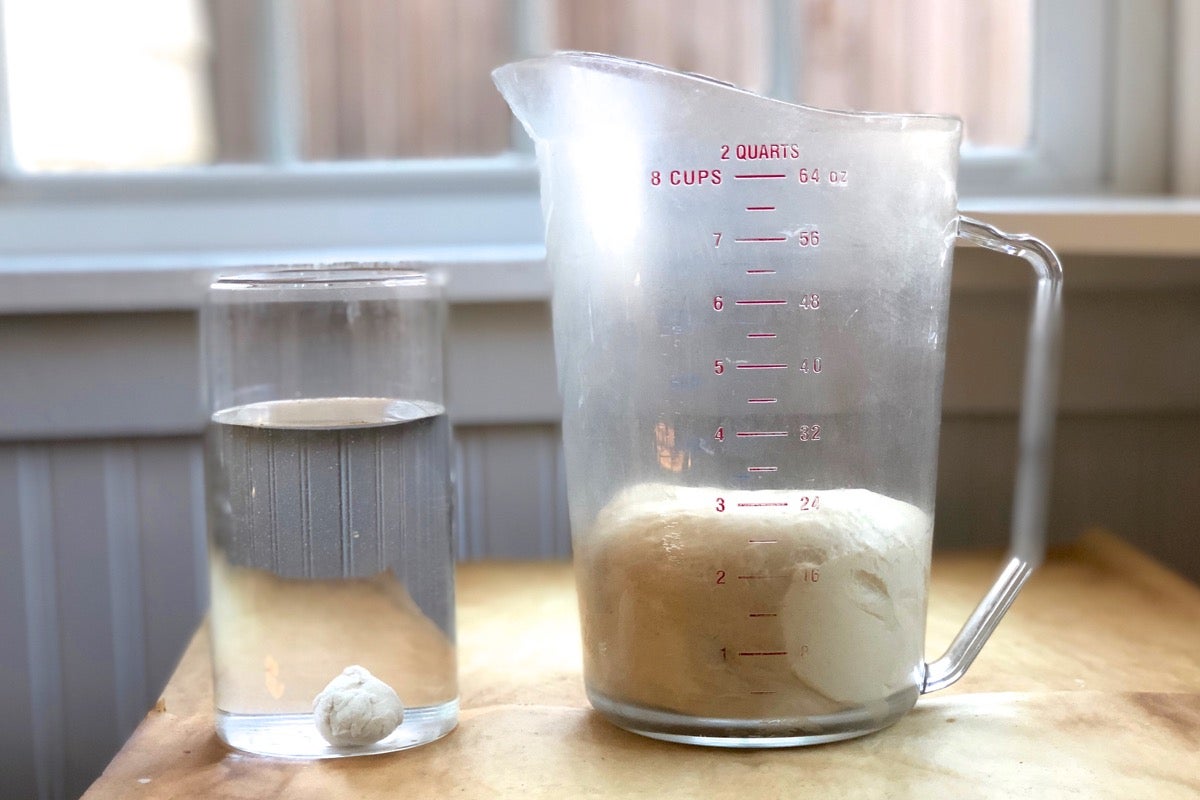
You can build your leaven with 50 g starter 100 g water and 100 g flours 5050 all-purposewhole wheat flour the night before you plan on mixing your dough. I feed my starter the night before I bake.

The float test is not accurate or necessary which is why I dont recommend that you use it.
Float test for sourdough starter. So is the float test a good way to assess the rise of yeast dough or baking readiness of sourdough starter. Both partially risen yeast dough and growing but not yet ripe starter will float in water. If rising yeast dough or fed sourdough starter sinks in water its definitely not ready to continue to the next step in your recipe.
Heres how to do the FLOAT TEST to check if your sourdough starter is ready to useIf you want to make your own sourdough starter from scratch download my f. Sourdough Starter Float Test - YouTube. Sourdough Starter Float Test.
If playback doesnt begin shortly try restarting your device. The Float Test. Wed be remiss not to tell you about another test.
The float test is simpler but less reliable than the volume test. Add 1 teaspoon of your starter to at least 1 cup of a room temperature water. If it floats your starter is ready for baking.
The float test is a measure of how active your starter is based on how much trapped CO2 is in it. I feed my starter the night before I bake. I remove all but a tablespoon soup spoon and add 200 grams of flour and 200 grams of water.
I mix it with my hands cover it and leave it on the kitchen counter overnight. The float test works The float test will let you know if there is enough gas in your starter to permit it to float and 99 of the time this will indicate that your starter is ready to make some darn good sourdough. The best hydration level for a sourdough starter to pass the float test is 100.
This means that for every 100g of flour thats added 100g of water must also be added a 11 of flourwater. Using a hydration level thats too high will leave you with something thats too gloopy and wont be able to hold any gas. The float test is the method by which you determine if your starter is active enough to work in creating a good sourdough loaf.
If it floats its ready. If it sinks it needs to be fed first. In order to float test your sourdough starter youll fill a cup with room temperature water and drop a half teaspoon of starter in.
Failed float tests generally indicate the following. Your sourdough starter is too young and not strong enough for bread baking. The starter is strong and active but not quite ready.
Allow the starter to sit at temperature for another 30 minutes or. No its the levain for the float test. By morning the leaven will be aerated by wild yeast activity and the volume will have increased by about 20.
The most reliable indication that your leaven is ready is if it floats in water Hes talking about levain not starter. Grab the kids for an impromptu science experiment when you test your sourdough starter in water. Place about a teaspoon of the starter into a cup of warm water.
If it floats it should be ready for baking. Even if your starter doesnt float it could still be ready. Go by the volume test to be sure.
My starter wont pass the float test. The float test is not accurate or necessary which is why I dont recommend that you use it. The best way to tell if a sourdough starter is strong enough to raise bread is to watch it after feeding.
If it doubles at least in 6-10 hours it is capable of raising the bread. Therefore why would you want to muck about trying to do a float test. I reckon this is one of the greatest furphys that has ever been perpetrated on the sourdough community - that this is a necessary prerequisite test for starter readiness.
I suspect that what is happening is that in extracting the sample to do the float test all of the. Those cues separated became thin and did not float mean that your starter is hungry. It is now more active and will require more frequent feedings.
It will require a bit of trial and error but you want to perform the float test before it gets to that thinseparated statewhile its tallest most poofyfoamy and smells of yeastinessfruitiness not overly sour. Your starter shouldnt need to pass the float test but your leaven will. You can build your leaven with 50 g starter 100 g water and 100 g flours 5050 all-purposewhole wheat flour the night before you plan on mixing your dough.
This sits on the counter overnight and when you wake up youll do the float test on the leaven to make sure its ready to bake with. How to do the Float Test Fill up a jug with tepid water at 30-35C Tear a small piece of sourdough starter and drop it into the water Wait 5 minutes See if the dough floats or sinks. When the hydration of your starter or levain is sufficiently low the float test becomes less accurate and in most cases doesnt ever pass.
Instead of using the float test observe the actual culture and how its progressing.